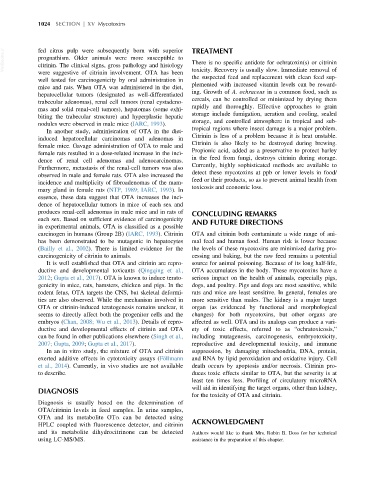Page 1092 - Veterinary Toxicology, Basic and Clinical Principles, 3rd Edition
P. 1092
1024 SECTION | XV Mycotoxins
VetBooks.ir fed citrus pulp were subsequently born with superior TREATMENT
prognathism. Older animals were more susceptible to
There is no specific antidote for ochratoxin(s) or citrinin
citrinin. The clinical signs, gross pathology and histology
were suggestive of citrinin involvement. OTA has been toxicity. Recovery is usually slow. Immediate removal of
the suspected feed and replacement with clean feed sup-
well tested for carcinogenicity by oral administration in
plemented with increased vitamin levels can be reward-
mice and rats. When OTA was administered in the diet,
ing. Growth of A. ochraceus in a common food, such as
hepatocellular tumors (designated as well-differentiated
cereals, can be controlled or minimized by drying them
trabecular adenomas), renal cell tumors (renal cystadeno-
rapidly and thoroughly. Effective approaches to grain
mas and solid renal-cell tumors), hepatomas (some exhi-
storage include fumigation, aeration and cooling, sealed
biting the trabecular structure) and hyperplastic hepatic
storage, and controlled atmosphere in tropical and sub-
nodules were observed in male mice (IARC, 1993).
tropical regions where insect damage is a major problem.
In another study, administration of OTA in the diet-
Citrinin is less of a problem because it is heat unstable.
induced hepatocellular carcinomas and adenomas in
Citrinin is also likely to be destroyed during brewing.
female mice. Gavage administration of OTA to male and
Propionic acid, added as a preservative to protect barley
female rats resulted in a dose-related increase in the inci-
in the feed from fungi, destroys citrinin during storage.
dence of renal cell adenomas and adenocarcinomas.
Currently, highly sophisticated methods are available to
Furthermore, metastasis of the renal-cell tumors was also
detect these mycotoxins at ppb or lower levels in food/
observed in male and female rats. OTA also increased the
feed or their products, so as to prevent animal health from
incidence and multiplicity of fibroadenomas of the mam-
toxicosis and economic loss.
mary gland in female rats (NTP, 1989; IARC, 1993). In
essence, these data suggest that OTA increases the inci-
dence of hepatocellular tumors in mice of each sex and
produces renal-cell adenomas in male mice and in rats of CONCLUDING REMARKS
each sex. Based on sufficient evidence of carcinogenicity AND FUTURE DIRECTIONS
in experimental animals, OTA is classified as a possible
carcinogen in humans (Group 2B) (IARC, 1993). Citrinin OTA and citrinin both contaminate a wide range of ani-
has been demonstrated to be mutagenic in hepatocytes mal feed and human food. Human risk is lower because
(Bailly et al., 2002). There is limited evidence for the the levels of these mycotoxins are minimized during pro-
carcinogenicity of citrinin to animals. cessing and baking, but the raw feed remains a potential
It is well established that OTA and citrinin are repro- source for animal poisoning. Because of its long half-life,
ductive and developmental toxicants (Qingqing et al., OTA accumulates in the body. These mycotoxins have a
2012; Gupta et al., 2017). OTA is known to induce terato- serious impact on the health of animals, especially pigs,
genicity in mice, rats, hamsters, chicken and pigs. In the dogs, and poultry. Pigs and dogs are most sensitive, while
rodent fetus, OTA targets the CNS, but skeletal deformi- rats and mice are least sensitive. In general, females are
ties are also observed. While the mechanism involved in more sensitive than males. The kidney is a major target
OTA or citrinin-induced teratogenesis remains unclear, it organ (as evidenced by functional and morphological
seems to directly affect both the progenitor cells and the changes) for both mycotoxins, but other organs are
embryos (Chan, 2008; Wu et al., 2013). Details of repro- affected as well. OTA and its analogs can produce a vari-
ductive and developmental effects of citrinin and OTA ety of toxic effects, referred to as “ochratoxicosis,”
can be found in other publications elsewhere (Singh et al., including mutagenesis, carcinogenesis, embryotoxicity,
2007; Gupta, 2009; Gupta et al., 2017). reproductive and developmental toxicity, and immune
In an in vitro study, the mixture of OTA and citrinin suppression, by damaging mitochondria, DNA, protein,
exerted additive effects in cytotoxicity assays (Fo ¨llmann and RNA by lipid peroxidation and oxidative injury. Cell
et al., 2014). Currently, in vivo studies are not available death occurs by apoptosis and/or necrosis. Citrinin pro-
to describe. duces toxic effects similar to OTA, but the severity is at
least ten times less. Profiling of circulatory microRNA
will aid in identifying the target organs, other than kidney,
DIAGNOSIS
for the toxicity of OTA and citrinin.
Diagnosis is usually based on the determination of
OTA/citrinin levels in feed samples. In urine samples,
OTA and its metabolite OTα can be detected using ACKNOWLEDGMENT
HPLC coupled with fluorescence detector, and citrinin
and its metabolite dihydrocitrinone can be detected Authors would like to thank Mrs. Robin B. Doss for her technical
using LC-MS/MS. assistance in the preparation of this chapter.

